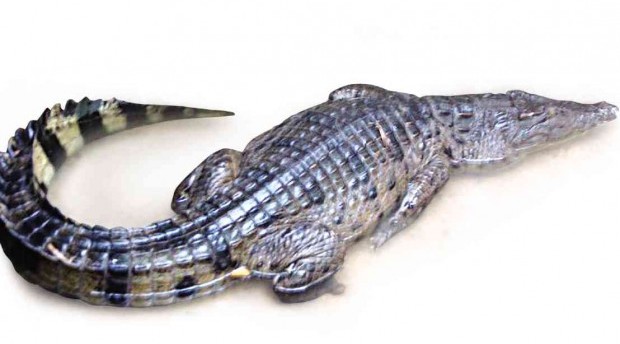
MALANG the freshwater crocodile has become a celebrity in M’lang, North Cotabato province, a town that wants to keep basking in Malang’s fame. WILLIAMOR MAGBANUA/ INQUIRER MINDANAO
DUNGGUAN, M’lang, Philippines—Malang, the largest freshwater crocodile captured here on April 12, is finally home.
Malang, obviously got a grand welcome from his own kind as a group of smaller reptiles was on the same spot where he was set free around 5 p.m. on Friday, officials said.
“Fresh footprints of smaller crocodiles were visible (at the edge) of the marsh; obviously Malang was not alone in the wild,” Mayor Joselito Pinol told the Inquirer.
“Maybe, they were aware of Malang’s homecoming and waited for him but ran away when they saw humans accompanying the Philippine crocodile (Crocodylus mindorensis),” he added in jest while pointing at crocodile footprints on the mud.
Malang was also visibly excited at being home. Before his release, Piñol said, he had shown some “excitement” through body movements.
The night before his release, Malang kept on moving around his enclosure near the town hall, one of his two caretakers said.
“It seems Malang knew that he would be released and reunited with other crocs in the Liguasan Marsh,” said Hernand Dapudong, Malang’s caretaker.
He said the crocodile often moved its tail and created splashes. Prior to this, Malang was calm.
“It was unusual because he had been calm since the local government took custody of him on April 13 from the fishermen who captured him,” Dapudong said.
As it was being transported back to the marsh from the town hall, Malang had unusual body movements, Pinol said.
He said the reptile would move its tail left and right during the two-hour trip from the town hall to this village.
When Malang was brought down from the dump truck through a hammock that six men helped to carry, he was calm again.
“If I had my way, I want to keep Malang to show our place is rich with endangered species and biodiversity… but we have laws to obey,” former town councilor Freddie Sales, one of Malang’s hammock bearers.
Reporters covering the return saw the emotional Sales wiping his tears with a handkerchief following the two-kilometer walk from the village center to the rim of the Liguasan Marsh, the 220,000-hectare catch basin that Malang grew in.
After the reptile was untied, Malang quickly glided to the water as the send off team and some 250 villagers roared and gave resounding applause.
Malang wiggled his tail so strongly that it created a big splash on the water as if bidding goodbye. He then slid underwater.
The spectators patiently waited for the crocodile to resurface but Malang was not seen again.
Veronica Guzman, manager of Philippine Wildlife Rescue and Conservation Center who accompanied the reptile on its way back home, said Malang was “in heat” and was now probably looking for a mate.
“During this summer season, Philippine Crocodiles mate and in all likelihood, reproduce,” Guzman said.
Guzman said the government’s crocodile center in Palawan had plenty of female Philippine crocodiles in its custody.
She said she was considering releasing soon a female reptile on the spot where Malang was released “for reproduction purposes.”
Guzman said there was a need to boost the population of freshwater crocodiles through human intervention because only about 200 of them, including Malang, remained, either in the wild or in conservation centers such as the PWRCC.
Dr. Cayetano Pomares, an animal science expert at the University of Southern Mindanao, said he was hoping that Malang could find a mate on his own and start to reproduce.
Malang, named after the town of M’lang, which sits at the edge of the Liguasan marsh, was captured by fishermen who tied him to a huge tree on April 12. They demanded P40,000 as “finders’ fee” but the government rejected it.
Piñol talked to the fishermen and told them crocodiles were an endangered species and, by law, a 12-month imprisonment and P1 million fine await those who capture and keep crocodiles. They eventually agreed to turn over the beast to the local government.
At 2.18 meters long, Malang was touted to be the largest freshwater crocodile ever caught. The record catch before him was just over five feet long.
In a short speech, Piñol reminded locals again not to catch crocodiles, adding that they were not hostile animals.
Guzman agreed by saying that crocodiles do not attack humans unless provoked.
“When you see crocs as you go fishing, just go away, never antagonize the reptiles for they are violent if provoked,” she said.
Malang’s kind is relatively small compared to the salwater species, which can grow massively.
Lolong, the 6.09 meter crocodile netted at the Agusan Marsh last year was of the saltwater species.
Lolong died after almost one and-a-half years in captivity.
RELATED STORIES
‘Malang,’ largest freshwater croc in captivity escaped for 5 hours, found
World’s largest crocodile Lolong is dead